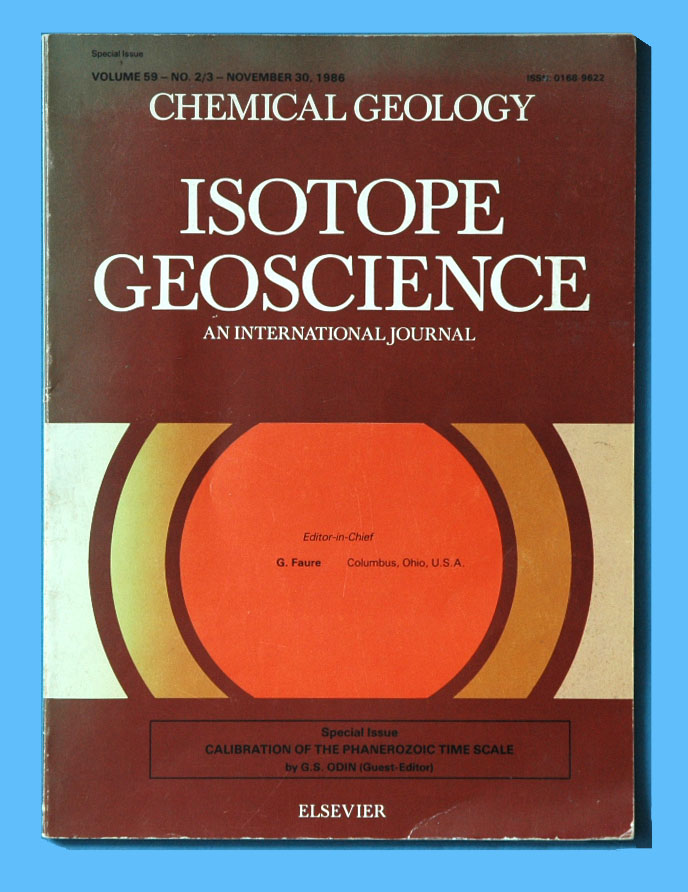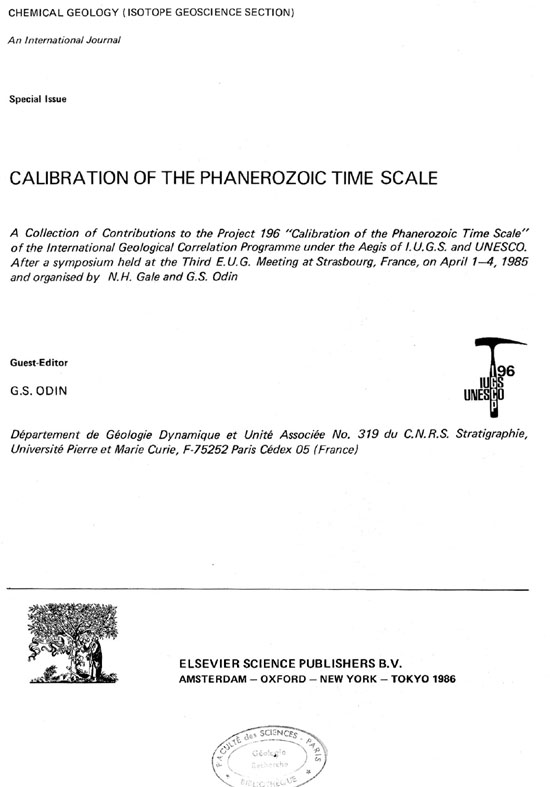Recent
advances in Phanerozoic time-scale calibration
G.S. Odin (Paris, France) 103
|
103
|
|
Radiometric dating
of a Caradocian tuff horizon
C.C. Rundle (London, Great Britain)
|
111
|
Âges
radiometriques K-Ar de biotites pyroclastiques sédimentées
dans le Wenlock de Gotland (Suède)
G.S. Odin, J.C. Hunziker (Berne), L. Jeppsson (Lund),
N. Spjeldnaes (Oslo)
|
117
|
K-Ar
biotite data for Ludlovian bentonites from Great-Britain
G.S. Odin (Paris), A.J. Hurford (Berne), D.J. Morrgan
(London), P. Toghill (Birmingham)
|
127
|
U-Pb zircon
dating of volcanic rocls, close to the Silurian-Devonian boundary from Vendée
(France)
J.J. Peucat, F. Paris (Rennes) & M. Chalet
(Poitiers)
|
133
|
40Ar/39Ar
ages of tonstein and tuff sanidine: new calibration points for the improvement
of the Upper Carboniferous time-scale
J.C. Hess & H.J. Lippolt (Heidelberg)
|
143
|
Contribution
to the numerical calibration of the Bajocian-Bathonian boundary; K-Ar and
palaeomagnetic data from the Les Vignes basaltic complex (Massif Centrl,
France)
H. Bellon, A. Fabre, B. Sichler (Brest), &
M.G. Bonhomme (Grenoble)
|
155
|
Isotopic
ages of the alkali rocks from the Nemuro Group in Hokkaido, Japan: Late
Cretaceous time-scale points
K. Shibata (Ibarali, Japan)
|
163
|
Le volcanisme
du "Biarritziano" de Vénétie (Italie): Ages K-Ar
sur basalte, plagioclase et céladonite
G.S. Odin, J. Hernandez, (Parsis), & J.C. Hunziher
(Berne)
|
171
|
40Ar/39Ar
laser-probe dating of North American tektite fragments from Barbados and
the age of theEocene-Oligocene boundary
B.P. Glass (Newark, USA), C.M. Hall & D. York
(Toronto)
|
181
|
40Ar/39Ar
age determinations on sanidine of the Eifel volcanic field (FR Germany);
constraints on age and duration of a Middle Pleistocene cold Period.
H.J Lippolt, U. Fuhrmann & H. Hradetzky ((Heidleberg)
|
187
|
The Cassignol
technique for potassium-argon dating, precision and accuracy: examples from
the Late Pleistocene to Recent volcanics from southern Italy
P.-Y. Gillot & U. Cornette (Gif-sur-Yvette,
France)
|
205
|
A major aim of the geochronology
is the estimate of the numerical age of the geological events. A more specific
task is the calibration of the geological relative dating expressed as a succession
of stages identified in the stratigraphic sequence to which many geological
works refer. Radiometric dating is the single possibility
to really calibrate this sequence. Several hypothetical interpolation
systems: equal stage duration, equal biozone duration, constant sedimentation
rate, constant biological evolution rate, constant sea-floor spreading rate
are frequently considered in order to fill up the still considerable gaps
between the key points established using the radiometric dating.
The
confidence level of the resulting interpolated dates remains directly related
to the accuracy of the radiometrically measured points as well as to the numbers
of the tie points available.
The project "Calibration
of the Phanerozoic Time Scale" of the International Geological
Correlation Programm (I.G.C.P., present project leaders: G. S. Odin &
A. J Hurford) has been set up in order to contribute:
(1) to the improvement
of the accuracy of the tie points available;
(2) to increase the number of those tie points; and
(3) to gather the knowledge in this field of research.
The present Special Issue
gathers some of the recent results. Half of them were presented during the
2nd Annual Meeting of the I.G.C.P. Project (Special Symposium convened by
N.H. Gale and G.S. Odin during E.U.G. III, Strasbourg, April 2, 1985); other
data were presented during the 4th Annual Meeting of the I.G.C.P. Project
(Special Symposium convened by G. S. Odin & N. J. Snelling during I.C.O.G.
VI, Cambridge July 2, 1986). The main progess recently achieved -of which
a small portion is presented here- appears to be the better understanding
of the significance of the different numbers calculated using different geochronometers
or different techniques; the Palaeozoic portion of the time scale is the one
for which the knowlledge was easier to improve. However, more research still
remains to be undertaken -especially using more sophisticated techniques and
increasing the number of tie points.
I would like to thank
the Authors of the herein presented contributions as well as those who contributed
to the research developed in the project for their help in improving the Numerical
Time Scale. I am also indebted to the publications services of Elsevier Science
Publishers and the Editor-in-Chief of the Journal, Professor G. Faure, for
their encouragement and help in editing this Special Issue of Isotope Geoscience.
G. S. ODIN
(Rédacteur invité)


